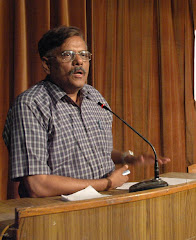Saturday, November 21, 2009
representation of communal violence
Author: Bede Scott a
Affiliation: a Nanyang Technological University, Singapore
DOI: 10.1080/17449850802410457
Publication Frequency: 4 issues per year
Published in: FPRIVATE "TYPE=PICT;ALT=journal" Journal of Postcolonial Writing, Volume 44, Issue 4 December 2008 , pages 345 - 354
Subjects: Creative Writing; Post-Colonial Studies;
Formats available: HTML (English) : PDF (English)
Previously published as: World Literature Written in English (0093-1705) until 2005
Article Requests: Order Reprints : Request Permissions
Abstract
This article explores the representation of communal violence in Vibhuti Narain Rai's 1988 novel Curfew in the City. Through a close reading of Rai's novel, I argue that such violence serves to “communalize” urban space on the Indian subcontinent - framing and reframing the boundaries between communities, establishing distinct ethno-religious enclaves, and attaching new meanings to public and private space. I then discuss the adverse impact this reconfiguration of space has on the status and disposition of minorities, alienating them from their environment and inducing in them a profound sense of displacement or “unbelonging”. In order to clarify this process, I invoke the concept of the architectural uncanny - Anthony Vidler's term for the feelings of “estrangement, alienation, exile, and homelessness” to which modern architecture gives rise. In this instance, however, I use it to describe the way in which communal violence defamiliarizes the Indian city, and in so doing transforms minority communities into symbolic foreigners or “virtual” refugees, permanently estranged from the urban space they occupy. Keywords: Vibhuti Narain Rai; communal violence; urban space; architectural uncanny
Affiliation: a Nanyang Technological University, Singapore
DOI: 10.1080/17449850802410457
Publication Frequency: 4 issues per year
Published in: FPRIVATE "TYPE=PICT;ALT=journal" Journal of Postcolonial Writing, Volume 44, Issue 4 December 2008 , pages 345 - 354
Subjects: Creative Writing; Post-Colonial Studies;
Formats available: HTML (English) : PDF (English)
Previously published as: World Literature Written in English (0093-1705) until 2005
Article Requests: Order Reprints : Request Permissions
Abstract
This article explores the representation of communal violence in Vibhuti Narain Rai's 1988 novel Curfew in the City. Through a close reading of Rai's novel, I argue that such violence serves to “communalize” urban space on the Indian subcontinent - framing and reframing the boundaries between communities, establishing distinct ethno-religious enclaves, and attaching new meanings to public and private space. I then discuss the adverse impact this reconfiguration of space has on the status and disposition of minorities, alienating them from their environment and inducing in them a profound sense of displacement or “unbelonging”. In order to clarify this process, I invoke the concept of the architectural uncanny - Anthony Vidler's term for the feelings of “estrangement, alienation, exile, and homelessness” to which modern architecture gives rise. In this instance, however, I use it to describe the way in which communal violence defamiliarizes the Indian city, and in so doing transforms minority communities into symbolic foreigners or “virtual” refugees, permanently estranged from the urban space they occupy. Keywords: Vibhuti Narain Rai; communal violence; urban space; architectural uncanny
Subscribe to:
Post Comments (Atom)






































No comments:
Post a Comment